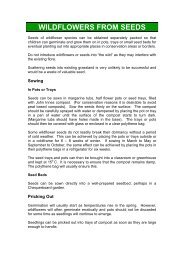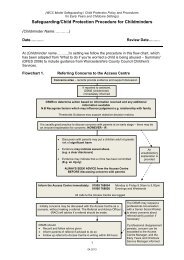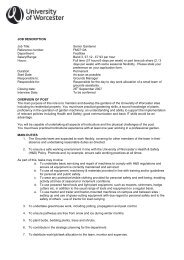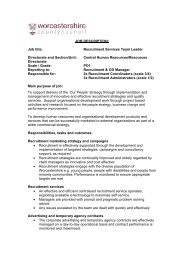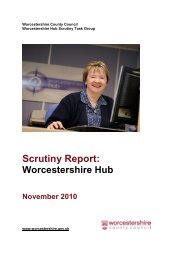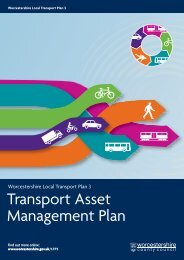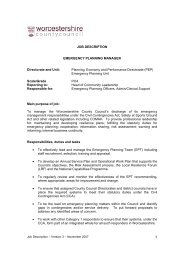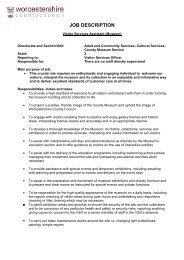Planning for Renewable Energy in Worcestershire Research Paper
Planning for Renewable Energy in Worcestershire Research Paper
Planning for Renewable Energy in Worcestershire Research Paper
Create successful ePaper yourself
Turn your PDF publications into a flip-book with our unique Google optimized e-Paper software.
6. <strong>Renewable</strong> <strong>Energy</strong> and the Environment of<strong>Worcestershire</strong>6.1 <strong>Renewable</strong> energy schemes canhave a visual and/or environmentalimpact on their surround<strong>in</strong>gs and on<strong>Worcestershire</strong>'s built and naturallandscape and biodiversity. Smallermethods of micro-generation, such asroof-mounted solar hot water panels, canrepresent unobtrusive additions to thestreetscape; however, the impact of a2MW w<strong>in</strong>d turb<strong>in</strong>e is likely to have agreater effect, be<strong>in</strong>g visible from aconsiderable distance. The potentiallydamag<strong>in</strong>g impacts result<strong>in</strong>g fromtechnologies can also differ. Migratorypatterns of birds, <strong>for</strong> example, may needto be considered <strong>in</strong> the sit<strong>in</strong>g andoperation of a large w<strong>in</strong>d turb<strong>in</strong>e or w<strong>in</strong>dfarm, whereas the <strong>in</strong>stallation of solarpanels on the roof of a house may requirea survey to <strong>in</strong>vestigate whether a bathabitat would be at risk, as bats are aprotected species.6.2 Whilst it is generally recognisedthat large-scale projects can havesignificant effects on their surround<strong>in</strong>gs, itis also crucial to consider the impact ofsmaller-scale <strong>in</strong>stallations. This applies tomost of the technologies listed <strong>in</strong>Appendix A, and <strong>in</strong>cludes the need toassess the potential cumulative effect of anumber of smaller systems.14In the case of w<strong>in</strong>d turb<strong>in</strong>es, the Susta<strong>in</strong>ableDevelopment Commission suggest, <strong>in</strong> 'W<strong>in</strong>d Power <strong>in</strong> theUK' (2005) that "There is a strong case <strong>for</strong> view<strong>in</strong>g w<strong>in</strong>ddevelopments as temporary structures, pend<strong>in</strong>glonger-term approval on landscape grounds. As fulldecommission<strong>in</strong>g is usually possible, last<strong>in</strong>g objectionscould potentially be remedied on a case-by-case basis bythe eventual removal of the turb<strong>in</strong>es at the end of theirwork<strong>in</strong>g lives".6.3 Cumulative impact can arise whena number of renewable energydevelopments (or the constituent parts ofa s<strong>in</strong>gle development) comb<strong>in</strong>e toheighten the effect of the development(s)on an area. An area judged as suitable <strong>for</strong>accommodat<strong>in</strong>g a renewable energydevelopment may not necessarily be ableto accommodate further development of asimilar type. Some renewables, such aslarge-scale w<strong>in</strong>d turb<strong>in</strong>es, may requireextensive ancillary structures such ascabl<strong>in</strong>g, access roads, ma<strong>in</strong>tenancebuild<strong>in</strong>gs and sub-stations. In comb<strong>in</strong>ationthese developments could result <strong>in</strong> a fargreater impact on the landscape than asolitary turb<strong>in</strong>e, and this should beconsidered <strong>for</strong> any such application.Similarly, whilst the grow<strong>in</strong>g of biofuels orbiomass on a small scale may beaccommodated without serious change tothe landscape, the wholesale diversion offields to the grow<strong>in</strong>g of oilseed rape, <strong>for</strong>example, could have dramatic impacts notonly on the landscape, but also onbiodiversity and amenity concerns. Thereis the potential <strong>for</strong> these impacts to bepositive as well as negative.6.4 It may be possible to limit theharmful effects on landscape, biodiversityor heritage by ensur<strong>in</strong>g reversibility <strong>in</strong>renewables proposals. This would allowthe site to be returned to its previous (orimproved) state after the end of its designlife or a specified period of time. This is apractice commonly encountered <strong>in</strong> theconditions of quarry<strong>in</strong>g developments,and could theoretically be extended torenewable energy <strong>in</strong>stallations, to ensurea site is fully remediated. 146. RENEWABLE ENERGY & THE ENVIRONMENT ● <strong>Plann<strong>in</strong>g</strong> <strong>for</strong> <strong>Renewable</strong> <strong>Energy</strong> <strong>in</strong> <strong>Worcestershire</strong>Technical <strong>Research</strong> <strong>Paper</strong> 15



